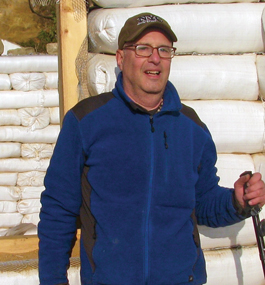Using Ordinary Dirt to Stand Up to Earthquakes

Courtesy Nathan Belofsky
Nathan Belofsky '81
For most Westerners, the catastrophic 2015 earthquake in Nepal is a distant memory. But it remains a driving force for Nathan Belofsky ’81, a New York City attorney who is moving heaven and earth to help the tiny Himalayan nation rise from the rubble.
Along with colleagues Kateryna Zemskova and Baris Tuncer, Belofsky founded Good Earth Nepal, a nonprofit based in both Kathmandu and New York, which is using a revolutionary technology to build houses and schools from hardened dirt.
“I wanted to do something to help” after the 7.8-magnitude quake hit Nepal, says Belofsky, who grew up in Quincy, Massachusetts. “At first, I raised and donated money for the victims, but then I heard about Earthbags.”
Using the Earthbag technology, developed by former Builders Without Borders director Owen Geiger, plain old everyday dirt is allowed to dry inside environmentally friendly bags. The result is a sustainable, affordable material that is stronger than cement or bricks.
At a construction site, the bags are stacked inside a deep foundation. Belofsky says buildings constructed with Earthbags are earthquake-resistant, unlike the thousands of structures that crumbled during last year’s tragedy, displacing millions of Nepali people.
“Nepal gives Earthbags a great testing lab,” says Belofsky, who majored in politics at Brandeis.
One big advantage to Earthbags, he says, is that anyone can learn how to use the technology. Good Earth Nepal has already used it to build a primary school with earthquake-resistant structures and foundations. Two other schools and a number of houses are also in the works.
Several months ago, Zemskova and Tuncer met with Nepal’s minister of education and Belofsky spoke with a group of United Nations officials to give them an update on all the construction and provide an Earthbag demonstration.
“I’d like to see the technology spread,” Belofsky says. “It will really help in developing countries. It’s so eco-friendly — it’s just dirt.”
Of course, building at a high elevation is anything but a breeze. Construction materials have to be transported up the mountains in people’s hands or on their backs, because roads aren’t navigable or they’re nonexistent.
But Belofsky, who estimates it takes 90 days to build a small school, says the work is worth it, considering what the results will mean for Nepal, not to mention the world.
— Julian Cardillo ’14
